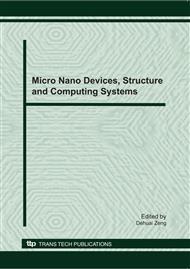p.628
p.634
p.638
p.644
p.650
p.656
p.662
p.667
p.671
Modeling and Comparative Analysis of Carbon Nanotube and Boron Nitride Nanotube Cantilever Biosensors
Abstract:
This paper investigates the bending deformation of a cantilever biosensor based on a single-walled carbon nanotube (CNT) and single-walled boron nitride nanotube (BNNT) due to bioparticle detection. Through 3-D modeling and simulations, the performance of the CNT and BNNT cantilever biosensors is analyzed. It is found that the BNNT cantilever has better response and sensitivity compared to the CNT counterpart. Additionally, an algorithm for an electrostatic-mechanical coupled system is developed. The cantilever (both BNNT and CNT) is modelled by accounting that a conductive polymer is deposited onto the nanotube surfaces. Two main approaches are considered for the mechanical deformation of the nanotube beam. The first one is differential surface stress produced by the binding of biomolecules onto the surface. The second one is the charge released from the biomolecular interaction. Also, different ambient conditions are considered in the study of sensitivity. Sodium Dodisyl Sulphate (SDS) provides better bending deformation than the air medium. Other parameters including length of beam, variation of beam’s location, and chiralities are considered in the design. The results are in excellent agreement with the electrostatic equations that govern the deformation of cantilever.
Info:
Periodical:
Pages:
650-655
Citation:
Online since:
December 2010
Authors:
Keywords:
Price:
Сopyright:
© 2011 Trans Tech Publications Ltd. All Rights Reserved
Share:
Citation:


